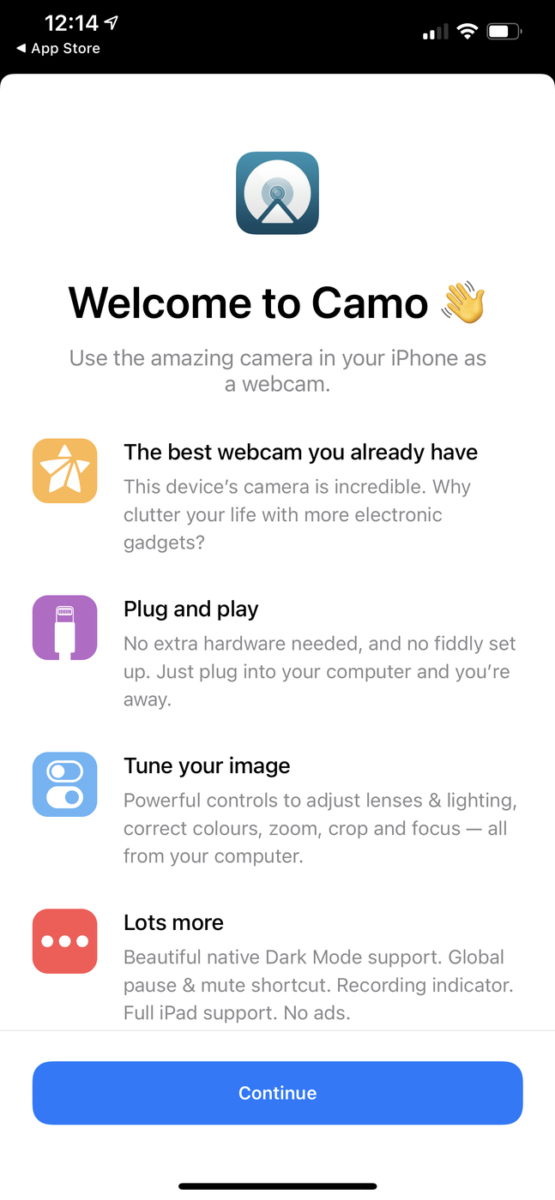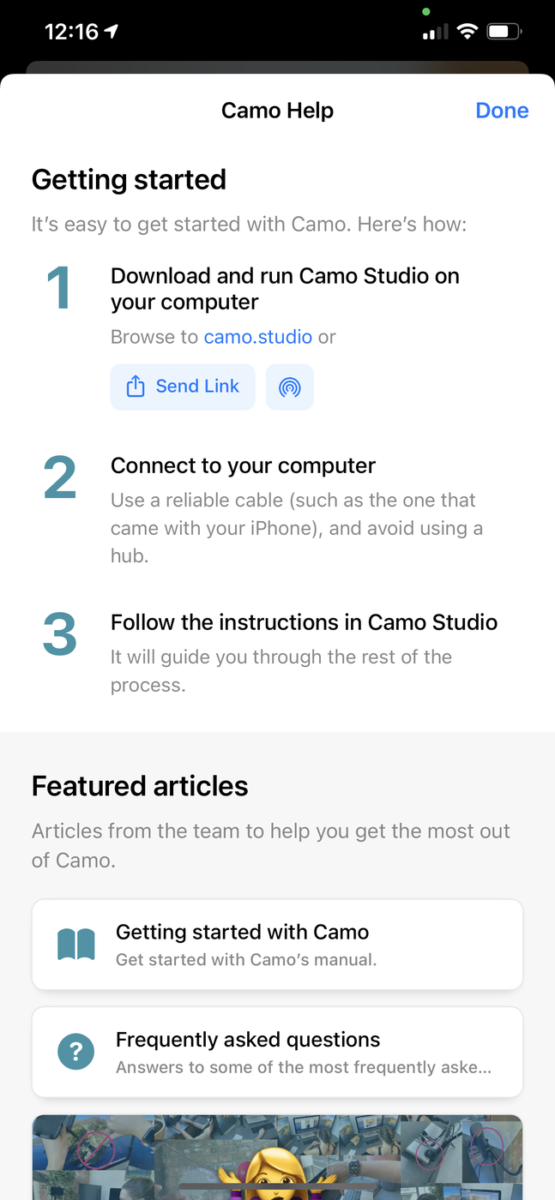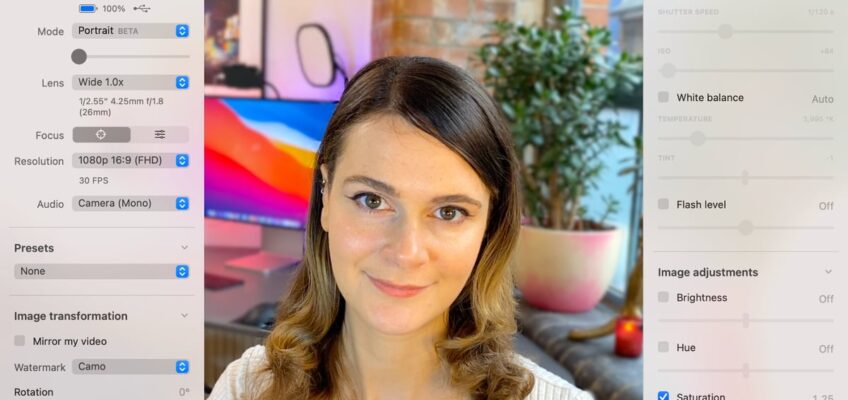Camo is an app that makes you look your best in your video calls without tracking users or selling their data.
It’s rare to find an app where even the free version is also free of advertisement. So what’s the catch? Surely it profits from user data in some way, there’s no such thing as a free lunch in tech…
In a nutshell, Camo is an app that turns your smartphone into a webcam Click To TweetYet according to Camo’s Founder Aidan Fitzpatrick, the app’s strict no-tracking policy is a point of principle, and there is, in fact, no need for such intrusion into user privacy. Enough of their users are happy to pay the very reasonable $4.99 a month for the “Pro version” to fund the free app as well.

In a nutshell, Camo is an app that turns your smartphone into a webcam. Like all great tech ideas, it’s a simple concept, well-executed.
Even cameras in older phones are much better than any webcam on the market, so by using that old phone sitting in your drawer doing nothing as a webcam, you can get next-level video quality.
A big part of the harm consumers face with advertising is their data, demographics, and tracking running across the web Click To TweetThe app has been used by the likes of Seth Godin, Wall St Journal’s Joanna Stern plus employees from Harvard, Stanford and Oxford Universities, who praise it for its ability to create a professional-quality webcam experience from the user’s phone and browser.
“I’ve spent years building products to help people get better access to their own data,” says Fitzpatrick, who founded his company Reincubate in 2008 after building the world’s first tool for iOS data recovery, which enabled users to securely manage their data.

There's a huge amount of competition by unworthy publishers, trying to rank low-quality services or information Click To Tweet
Working in that space for so long gave him many opportunities to see the more distasteful ways to use data, and the wide range of bad actors out there looking to get access to it, he explains as he unpacks how important the issue is to him.
“The internet has played a big role in my life and my career, and it’s in almost everyone’s interests to push it along the responsible, sustainable path of public good rather than narrow, private interests.”
Fighting Fakery
Fitzpatrick talks about the idea that consumers on the web these days are surrounded by “fakery.”
Yet while some forms of fakery — fake news, fakery in public discourse, and the use of trolls to attack viewpoints on social media – have been widely discussed, there is a lot more to it than that, he explains.
Even cameras in older phones are much better than any webcam on the market Click To Tweet“Fakery pays off for the unethical. Amazon and other platforms have received coverage for fake product reviews on their platforms. Instagram is busy with promoted products, many of which use fake reviews and undisclosed influencer endorsements. Sometimes even the products themselves are fake.”
“More broadly, consumers have experience with this fakery on Google. There are some Google searches that are just hard to do. Have you ever tried searching for a plumber or medical advice on Google? There’s a huge amount of competition by unworthy publishers, trying to rank low-quality services or information.”
Even services like Grubhub and Postmates have been criticized for allegedly faking profiles for restaurants that they don’t partner with, in an attempt to capture and redirect their leads. “A big part of the harm consumers face with advertising is their data, demographics, and tracking running across the web,” says Fitzpatrick
Making it Pay
While Fitzpatrick believes that consumer privacy and choice have been jeopardized by large web corporations and social media giants, he recognizes that they must make money.
His argument, however, is that there is no need for such companies to be so data-hungry in capturing and monetizing information about their users. It is, in fact, still possible for them to build effective first-party advertising networks with a smaller set of data.
“Paid services along the lines that Apple focuses on, or which Google have explored with YouTube Music may prove increasingly worthwhile.”
And of course, his own product manages to make money without storing and tracking consumer data:
“Our model is very simple: we offer a free version of our products, and a paid version. We’ve no need to track data for trials, or to try and monetize with ads baked into our products, so we don’t.”
Algorithm Anarchy
He breaks down this disruptive rationale into three key areas that those designing tech products must think about to enable consumers to have more authentic experiences online:
- Product: We don’t track user data in the products. We have no need to, and no interest in doing so. People’s data belongs to them. If the app fails, we do record information on what went wrong, but that’s clearly metadata, and about the functioning of the product in order that we can improve it, rather than anything about the customer. Where we record limited metadata on how the app is used, we only do for the purpose of better understanding and developing our own product — not for marketing — and we don’t share that information with any third parties.
- Customer Records: If you buy something from a company, what data do they collect? We ask for the UK’s statutory minimum. We need their email and country of residence in order to send them the license and to apply the correct taxes. We use a third-party for card-processing, and don’t have any card details. In the UK we have to keep financial records for at least 6 years, but where users have lifetime licenses we need to keep that data for at least that time. Fortunately, it’s a very narrow set of data.
- Marketing: This is hard because overreach in data capture feels like the norm. Most systems that permit advertising ask customers to embed tracking tools in their mobile or desktop apps or on their sites, and this is something we push back on. We don’t embed any advertising analytics tools in our products for this reason. Then there’s visitor tracking. We do use an analytics product to count the number of visitors to our site, and we’ve more work to do as the industry evolves to get ourselves happier with how these systems work. We’ve made good progress.
“The tech industry often assumes that using particular channels to market a product requires tracking. We reject that. Reincubate will continue to safeguard consumer privacy and choice with our commitment to respect privacy, refuse data monetization and intrusive tracking.”

Camo key features include:
- Film-quality video
- Easy customizing: lighting, crop, zoom, focus, at your fingertips
- Plug and play
- Plays well with others: use with Zoom, Meet, Teams, Skype, Slack, Google Chrome, Cisco Webex Meetings +.
- Previews before going live
- The newly released 1.3 version offers even better functionality, including support for an additional 11 languages supported, power conservation, and screen aesthetic features.
Camo’s free edition is great for straightforward, high-quality calls, but lacks adjustments. It gives you resolutions up to and including 720p video, along with a choice of the device’s selfie lens, or it’s main back lens (the wide one). The free version of Camo also lets you access your device’s audio, and keep the screen of your device dimmed while using Camo. With free version, you can also connect multiple iOS devices and switch between them.
If you upgrade to Camo Pro, you get the following:
- Access to every lens on your phone (such as selfie, telephoto, ultra-wide & wide)
- “Portrait mode” on iPhone’s that support it, with bokeh effect and shallow depth-of-field
- Control of the device’s flash for use as a light ( turn it on and off, control the brightness)
- Access to any resolution the device provides (opening up 1080p and 1440 x 1080)
- Video mirroring
- Rotation of the feed in 90° increments (in case your phone is orientation locked)
- Zoom controls, with pan and tilt to keep you front and centre
- Focus adjustments (autofocus, focus on a particular area, manual focus control)
- Shutter speed and ISO adjustments
- Image adjustments including brightness, temperature, tint, hue, saturation, contrast, gamma, sharpness
Alice Bonasio is a technology journalist, communications consultant and Tech Trends’ Editor in Chief. Connect with her on LinkedIn and follow @alicebonasio and @techtrends_tech on Twitter.









